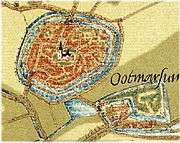Capture of Ootmarsum
The Capture of Ootmarsum in 1597 was a short siege, that took place during the Eighty Years' War and the Anglo–Spanish War by a Dutch and English army led by Count Van Duivenvoorde while Maurice of Nassau was besieging Oldenzaal. The siege lasted from 19 to 21 October, where the Spanish garrison of Ootmarsum under the governor, Otto Van Den Sande, surrendered and was then occupied by the besiegers. The siege was part of Maurice's successful offensive against the Spaniards during the same year.[2]
After the capture of Enschede and with the exodus of the surrendered Spanish garrison, Maurice went with the Dutch and English army to Oldenzaal.[3] Before Maurice got there however he decided then to split his army with the main army headed to Oldenzaal and a force under Count Van Duivenvoorde sent to Ootmarsum in order to submit the city to his authority.[4]
Siege and capture
As with the capture of Enschede the same process took place; a Dutch trumpeter under a flag of truce was sent to the gate of Ootmarsum to demand the surrender. Duivenvoorde threatened that under Maurice's orders his army would inflict the same destruction that befell Bredevoort and Groenlo during their capture a few weeks before.[5] The garrison commander Otto van den Sande replied that the King had commanded him to defy the besiegers and hold firm and that he himself could not surrender as only someone with a higher authority could so.[4] Sande thus ordered continuous cannon fire from the ramparts which continued over the whole night, causing casualties amongst the English troops digging a siege trench.[4]

Maurice on hearing the report of the resistance, subsequently sent four heavy guns to Ootmarsum. The following evening Dutch engineers started to make approaches towards the cities southern ramparts and spent that time putting two large siege guns in position. On the north side English troops and engineers did the same and brought up three artillery cannons in position. In Ootmarsum the following day the new siege works were noticed and the incessant bombardment was resumed on these newly dug positions.[4]
Van den Sande soon realized his position was hopeless and with no hope of relief asked for the written terms of Maurice to be handed over.[5] This time there was immediate capitulation, and the company of Spanish and German troops consisting of 120 men pulled out of the city, taking with them two banners, two guns, 800 pounds of gunpowder, 2000 fuses, four tons of flour, and other provisions.[4] The written honors of war was that the garrison was to remain behind the Meuse for the allotted time of three months where they were not to engage in combat.[4]
Dutch and English troops took over and Van Duivenvoorde ordered the fortifications and outer moat of Ootmarsum to be demolished as had been done in Enschede. At the same time, Maurice with the main army was busy with the siege of Oldenzaal which capitulated a day later.[1]
See also
References
- Citations
- Motley pg 422
- van Nimwegen pg 166
- Knight, Charles Raleigh: Historical records of The Buffs, East Kent Regiment (3rd Foot) formerly designated the Holland Regiment and Prince George of Denmark's Regiment. Vol I. London, Gale & Polden, 1905, p. 45
- Duyck, Anthonis (1864). Journaal, 1591-1602: Uitg. op last van het departement van Oorlog, met in leiding en aantekeningen door Lodewijk Mulder, Volume 2. Nijhoff. pp. 395–97 (Dutch).
- Wagenaar pg 474-75
- Bibliography
- Fissel, Mark Charles (2001). English warfare, 1511–1642; Warfare and history. London, UK: Routledge. ISBN 978-0-415-21481-0.
- Motley, John Lothrop. History of the United Netherlands: from the death of William the Silent to the Synod of Dort, with a full view of the English-Dutch struggle against Spain, and of the origin and destruction of the Spanish armada (Volume 3).
- van Nimwegen, Olaf (2010). The Dutch Army and the Military Revolutions, 1588-1688 Volume 31 of Warfare in History Series. Boydell & Brewer. ISBN 9781843835752.
- Markham, C. R. (2007). The Fighting Veres: Lives Of Sir Francis Vere And Sir Horace Vere. Kessinger Publishing. ISBN 978-1432549053.
- Israel, Jonathan. (1997). Conflicts of Empires: Spain, the Low Countries and the Struggle for World Supremacy, 1585-1713. Continuum. ISBN 9780826435538.
- Jan Wagenaar et al. (1753): Vaderlandsche Historie, Vervattende Geschiedenislessen der Vereenigde Nederlanden, in Zonderheid die van Holland, van de Vroegste Tyden af - Achtste Deel Amsterdam: Isaak Tirion (Dutch)